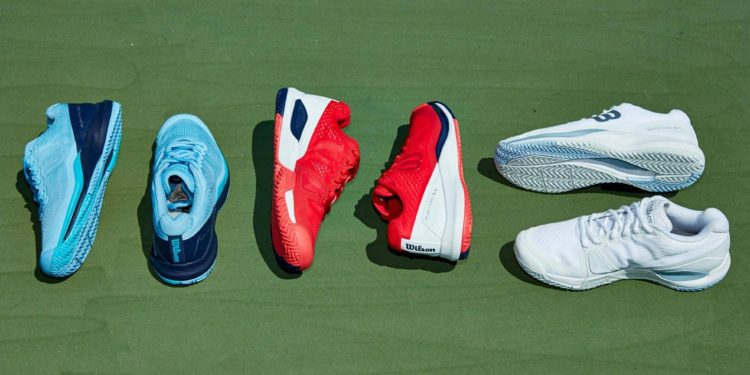Weight of Tennis Shoes:
On average, tennis shoes for both men and women typically weigh between 10 ounces (283 grams) to 17 ounces (481.942 grams) per shoe. The weight of tennis shoes can vary for both men and women. The man shoes weight range is between 11 and 16.9 ounces in size 10.5 or 11, while women’s shoes fall between 8.9 and 13.1 ounces in size 8 or 9. However, there is generally no significant difference in weight based on gender. The weight of tennis shoes depends more on the brand, style, and materials used in their construction rather than the gender of the wearer. These weights are approximate and can vary from shoe to shoe. It’s always a good idea to check the specific manufacturer’s specifications for the most accurate weight information for a particular pair of tennis shoes.
Factors Affecting Tennis Shoe Weight
Tennis shoes’ weight is influenced by various factors, including:
Material Composition
The materials used in the construction of tennis shoes play a vital role in determining their weight. Lightweight synthetic fabrics, mesh, and modern textile technologies can significantly reduce shoe weight while maintaining durability and support.
Design and Construction
The design and construction of tennis shoes can vary, leading to differences in weight. Innovative design techniques, such as seamless constructions and minimalist approaches, contribute to lighter shoes without compromising performance.

Additional Features
Some tennis shoes come with additional features, such as extra cushioning, ankle support, or specialized outsoles. These added components can affect the overall weight of the shoe.
Also, read about Tennis Shoes Brands in 2023
Lightweight Tennis Shoes: Advantages and Disadvantages
Enhanced Speed and Agility
Lightweight tennis shoes offer the advantage of improved speed and agility on the court. The reduced weight allows for quicker movements, faster accelerations, and more efficient changes in direction.
Reduced Fatigue
With less weight to carry, lightweight tennis shoes can help reduce fatigue during long matches or intense training sessions. Players can conserve energy and maintain their performance levels for extended periods.
Impact on Stability and Support
While lightweight shoes provide agility, they may compromise stability and support compared to heavier options. Players with a history of ankle or foot injuries might prefer shoes with additional support features.
Durability Concerns
Extreme lightweight designs may sacrifice durability, as they often prioritize weight reduction over long-term resilience. Players who engage in intense activities or have aggressive footwork might prefer slightly heavier shoes for enhanced durability.
Tennis Shoe Weight Categories
Tennis shoes can be broadly categorized based on weight:
Lightweight Tennis Shoes
These shoes prioritize agility and speed, ideal for players who rely on quick movements and swift responses. They are favored by baseliners and players who prefer a lightweight feel.
Midweight Tennis Shoes
Midweight shoes strike a balance between agility and stability. They offer moderate weight reduction while providing additional support and cushioning. They suit a wide range of playing styles.
Heavyweight Tennis Shoes
Designed for players who prioritize stability and support over agility, heavyweight tennis shoes offer enhanced cushioning and durability. They are commonly preferred by players with aggressive playing styles.
Also, read about Why Tennis Shoes are Important
How to Choose the Right Weight for Tennis Shoes
To select the optimal weight of tennis shoes, consider the following factors:
Playing Style and Preferences
Identify your playing style and personal preferences. Do you value speed and agility over stability and support? Assessing your priorities will help determine the weight category that suits you best.
Court Surface
Different court surfaces have varying demands. For hard courts, lightweight or midweight shoes can provide the necessary agility. Clay courts may benefit from slightly heavier shoes with improved traction, while grass courts may require lighter shoes to reduce surface impact.
Foot Type and Pronation
Understanding your foot type and pronation pattern is crucial in choosing the right tennis shoe weight. Players with high arches or under pronation may prefer lighter shoes for additional flexibility, while those with low arches or overpronation might benefit from midweight shoes for better support.
Training and Competitive Level
Consider your training regimen and competitive level. Intense training or frequent matches may require more durable midweight shoes, while occasional recreational play may allow for lightweight options.
Balancing Weight with Other Important Factors
While weight is an important consideration, it should be balanced with other crucial factors that impact performance:
Cushioning and Comfort
Opt for tennis shoes that offer adequate cushioning and overall comfort. Proper cushioning helps absorb impact during movements and reduces the risk of injuries.
Support and Stability
Ensure that the chosen shoes provide ample support and stability, especially if you have a history of ankle or foot issues. The right combination of weight and support will allow you to perform at your best while minimizing the risk of injuries.
Traction and Grip
Consider the shoe’s traction and grip properties, particularly for different court surfaces. A well-designed outsole with appropriate grip patterns can enhance your footwork and prevent slips.
Breathability and Ventilation
Breathable tennis shoes with proper ventilation channels help keep your feet cool and dry during extended matches. This factor contributes to overall comfort and reduces the risk of blisters or discomfort.
Maintaining the Optimal Performance of Tennis Shoes
To ensure your tennis shoes perform optimally throughout their lifespan, follow these maintenance tips:
Cleaning and Care
Regularly clean your tennis shoes according to the manufacturer’s instructions. Proper care and cleaning can prevent dirt and debris from affecting the shoe’s performance.

Replacement and Rotation
Replace your tennis shoes when they show signs of significant wear or when the outsole starts to deteriorate. Additionally, rotating between multiple pairs of shoes can extend their lifespan.
Storage and Protection
Store your tennis shoes in a cool, dry place away from direct sunlight. Avoid placing heavy objects on top of them to prevent deformation. Using a shoe bag or dedicated storage compartment can offer additional protection.
Conclusion
On average, tennis shoes for both men and women typically weigh between 10 ounces (283 grams) to 17 ounces (481.942 grams) per shoe. The man shoes weight range is between 11 and 16.9 ounces in size 10.5 or 11, while women’s shoes fall between 8.9 and 13.1 ounces in size 8 or 9. The weight of tennis shoes is a critical factor that can impact your performance on the court. Choosing the right weight category based on your playing style, court surface, foot type, and preferences is essential. Remember to balance weight with other important factors like cushioning, support, traction, and breathability to optimize your performance and minimize the risk of injuries.
Frequently Asked Questions (FAQs)
- Are lightweight tennis shoes suitable for all players?
- Lightweight shoes are ideal for players who prioritize speed and agility. However, players with specific foot conditions or stability concerns should consider additional support features.
- Do heavyweight tennis shoes affect my performance negatively?
- Heavyweight shoes can provide enhanced stability and support but may hinder agility. Players with aggressive playing styles may benefit from the added durability and cushioning.
- Can the weight of tennis shoes impact my speed?
- Yes, lighter tennis shoes can contribute to improved speed due to reduced weight. However, individual factors and playing style also play a significant role.
- How often should I replace my tennis shoes?
- Tennis shoes should be replaced when they show signs of significant wear or after approximately 45-60 hours of play, depending on the intensity of your game.
- Are midweight shoes a good compromise for most players?
- Midweight shoes offer a balance between agility and stability, making them suitable for a wide range of players and playing styles.











